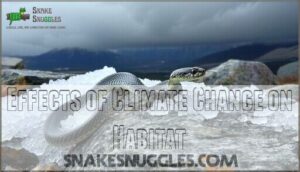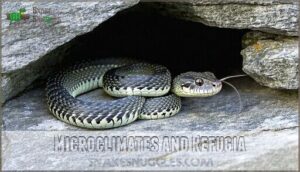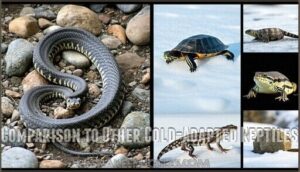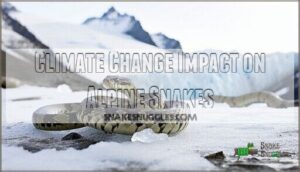This site is supported by our readers. We may earn a commission, at no cost to you, if you purchase through links.
 You’ll find that alpine snake species cold adaptation represents nature’s masterclass in survival engineering.
You’ll find that alpine snake species cold adaptation represents nature’s masterclass in survival engineering.
These mountain-dwelling serpents can’t rely on simple sunbathing like their lowland cousins – they’ve evolved antifreeze proteins that prevent ice crystals from forming in their blood, plus specialized metabolic processes that function like internal heating systems.
Cold-adapted species such as the alpine viper use precise habitat selection, modified hibernation patterns, and cellular-level protections to survive months of subfreezing temperatures.
Their thermoregulatory behaviors are so sophisticated that some species remain active at temperatures that would completely shut down warm-climate snakes.
These remarkable adaptations reveal secrets that could revolutionize our understanding of thermal survival strategies.
Table Of Contents
- Key Takeaways
- Alpine Snake Cold Adaptation
- Cold-Climate Habitat Requirements
- Reptile Thermal Ecology
- Climate Change Impact on Alpine Snakes
- Conservation and Research Priorities
- Frequently Asked Questions (FAQs)
- What are the adaptations of alpine biomes?
- How do alpine plants adapt to their environment?
- How cold can snakes survive?
- What adaptations do snakes have?
- How do rattlesnakes adapt to their environment?
- Can snakes survive extreme temperature fluctuations?
- How do snakes adapt to cold weather?
- Do reptiles have adaptations to survive in cold regions?
- How do alpine snakes regulate their body temperature?
- Do alpine snakes hibernate, and for how long?
- Conclusion
Key Takeaways
- You’ll discover that alpine snakes produce antifreeze proteins in their blood to prevent ice crystal formation, while dramatically slowing their heart rate by 50-80% and reducing metabolic demands by 40-60% during cold periods.
- You’ll find these mountain survivors use sophisticated behavioral strategies like communal hibernation in underground dens, precise morning basking on sun-warmed rocks, and strategic microclimate selection to maximize heat absorption.
- You’ll see that climate change poses serious threats to these cold-adapted specialists, forcing them to move 300-600 meters higher in elevation and potentially losing 70% of their suitable habitat by 2100.
- You’ll need to support conservation efforts that focus on habitat connectivity, protecting thermal refugia, and maintaining genetic diversity, since these snakes can’t adapt fast enough to keep pace with rapidly changing mountain climates.
Alpine Snake Cold Adaptation
You’ll discover how alpine snakes master extreme cold through remarkable body changes that slow their heart rate, thicken their blood with antifreeze proteins, and redirect energy to essential organs.
These high-altitude survivors also rely on clever behaviors like communal hibernation dens and precise morning basking rituals to outlast winter’s harsh grip, using communal strategies to survive.
Physiological Adaptations to Cold
Alpine snakes dial down their systems when temperatures drop.
When winter hits, these mountain survivors become masters of energy efficiency—slowing heartbeats and shutting down non-essentials to outlast the freeze.
You’ll find their metabolic rate slashes energy demands, while heart rate slows dramatically.
Here’s how physiological adaptations work:
- Metabolic Rate: Energy needs decrease by 40-60%
- Heart Rate: Drops 50-80% during cold periods
- Blood Flow: Redirects to essential organs only
- Antifreeze Proteins: Prevent deadly ice crystal formation
Skin thickness increases for insulation too.
Behavioral Adaptations to Cold
After slowing their systems, these clever snakes warm up with precise basking strategies, then slip into tight burrows for safety from the chill.
They use microclimate selection to pick sunlit rocks or hidden crevices, changing their activity period to stay active when conditions are cozy.
Huddling behavior kicks in when things get frosty—a real reptile sleepover, which involves group warmth and energy conservation.
| Basking Behaviors | Burrow Selection | Huddling Behavior |
|---|---|---|
| In sun patches | Rocky crevices | Group warmth |
| On flat rocks | Deep soil | Morning gatherings |
| Slow movement | Layered shelter | Energy conservation |
Genetic Adaptations to Cold
Beyond behavioral tricks, you’ll find genetic adaptations working like tiny molecular mechanics inside alpine snakes.
Gene expression shifts activate cold-sensing proteins through TRPM8 genes, while enzyme adaptation fine-tunes metabolic pathways.
Protein modification creates antifreeze compounds, and altered lipid composition keeps cell membranes flexible.
This genome evolution represents nature’s ultimate survival toolkit for alpine snake adaptation.
Some species even utilize cryoprotectants like glucose to prevent cellular damage from freezing.
Comparison to Other Reptiles
You’ll discover alpine snakes outperform other reptiles in cold environments.
While lizard cold hardiness and turtle hibernation exist, alpine snake adaptation surpasses them.
These snakes tolerate temperatures that cripple crocodilian thermoregulation and challenge tuatara adaptations.
Their reptile metabolic rates drop more dramatically than cousins, making snake cold tolerance exceptional among reptile thermal biology adaptations, showcasing alpine snake unique capabilities.
Conservation Implications
Up in those Alpine heights, keeping these snakes safe is like tending a rare bonsai—careful, ongoing, and thoughtful.
You’ll want habitat restoration, smart population monitoring, and strong conservation partnerships.
Mix in some climate mitigation and microclimate management, too.
Protecting critical snow depth is also essential for their survival.
These conservation strategies fight habitat fragmentation and thermal refugia loss, making sure no cold-adapted species faces climate change alone.
Cold-Climate Habitat Requirements
When you’re exploring alpine environments, you’ll discover that cold-climate snakes need specific habitat features to survive harsh mountain conditions.
These remarkable reptiles depend on thermal refuges, underground shelters, and carefully positioned basking sites that help them maintain their body temperature year-round, relying on these elements as key components of their survival strategy.
Thermal Landscape and Thermoregulation
When something’s chasing perfection in thermal management, alpine snakes master their environment through precise thermoregulation strategies. You’ll find these cold-weather specialists traversing thermal gradients like seasoned mountaineers, balancing energetic costs with survival needs.
Reptile owners often use digital reptile thermostats to maintain thermal consistency.
- Microclimate selection in rock crevices and burrows
- Strategic basking behavior during ideal sun exposure
- Efficient use of thermal refugia for temperature stability
- Active exploitation of diverse thermal landscape features
- Sophisticated reptile thermal ecology adaptations
Habitat Fragmentation and Isolation
Habitat fragmentation creates invisible barriers that trap alpine snake species in shrinking patches.
You’ll find populations becoming genetic islands where dispersal barriers prevent movement between suitable areas.
These connectivity corridors disappear, triggering genetic bottlenecks that reduce genetic diversity dramatically.
Metapopulation dynamics collapse when habitat loss isolates groups, making population viability questionable.
Conservation implications become serious as alpine snake species can’t maintain healthy breeding exchanges, basically creating biological dead zones where survival depends on increasingly limited resources.
Protecting snakes involves maintaining suitable habitats to guarantee their survival.
Effects of Climate Change on Habitat
One day you’re basking in sunshine, next, you’re dodging storms and shrinking territory.
Climate change isn’t just a headline—it’s shifting ranges, melting your thermal landscape, and making prey harder to find.
Overgrazing and habitat fragmentation stir up increased competition, while extreme weather ups the stress.
Alpine snake species’ cold adaptation is being pushed to its limits by relentless habitat loss.
As temperatures rise, snakes face challenges related to limited migration distances, which affects their ability to survive in a changing environment with relentless habitat loss.
Microclimates and Refugia
Alpine snake species rely on thermal refugia as nature’s built-in survival toolkit against harsh mountain conditions.
These microclimates create essential pockets where snakes can escape temperature extremes through strategic crevice usage and burrow selection.
Many herpetologists now utilize specialized snake habitats to study and protect these vulnerable creatures.
- Rock crevices provide natural insulation strategies against wind and cold
- South-facing slopes maximize solar heat absorption during brief sunny periods
- Underground burrows offer stable temperatures below the frost line
- Vegetation patches create microhabitat diversity with varied thermal options
Habitat Restoration and Protection
After identifying key microclimates, you’ll need robust habitat restoration and protection strategies.
Protected areas serve as climate refugia, but they’re only effective with proper land management. You must address invasive species threats while enhancing habitat connectivity between fragmented populations.
Many initiatives require specialized products for this purpose.
| Restoration Strategy | Protection Outcome |
|---|---|
| Remove invasive plants | Native vegetation returns |
| Create wildlife corridors | Alpine snake species migration improves |
| Establish buffer zones | Cold adaptation habitats expand |
| Monitor temperature refuges | Conservation strategies succeed |
Smart habitat protection isn’t just about fencing off areas—it’s about creating networks where snakes can thrive despite changing conditions.
Reptile Thermal Ecology
You’ll discover how alpine snakes master the art of temperature control in some of Earth’s harshest environments, where a few degrees can mean the difference between life and death.
Understanding their thermal ecology reveals the remarkable precision these cold-adapted reptiles use to exploit every available heat source while avoiding the energy costs of poor temperature choices, showcasing their ability to make precise decisions in harsh conditions, which is a key aspect of their thermal ecology.
Preferred Body Temperature and Its Influences
Beyond geographic boundaries, alpine snake species face complex body temperature preferences shaped by Environmental Factors.
Body size and latitude drive Optimal Temperature choices more than sex or reproductive status.
Larger snakes require different Physiological Processes for thermoregulation, while Evolutionary Pressures fine-tune these physiological adaptations.
You’ll find Behavioral Regulation varies substantially across populations, creating unique thermal strategies.
Thermoregulation Accuracy and Effectiveness
You’ll find that alpine snake species exhibit remarkable thermoregulation accuracy, maintaining body temperatures within just 0.45°C of their ideal range.
This precision showcases their physiological adaptations and behavioral plasticity in challenging mountain environments.
Their thermoregulation effectiveness allows them to maximize basking efficiency while minimizing energetic costs.
- Shelter selection becomes critical for maintaining perfect thermal conditions
- Physiological limits are pushed to extremes in harsh alpine climates
- Behavioral plasticity enables rapid responses to temperature fluctuations
- Thermal ecology strategies optimize survival in unpredictable mountain weather
Thermal Quality of Habitat and Its Variation
In mountainous terrain, thermal quality varies dramatically across microclimates, creating Habitat Thermal Gradients that snakes navigate for survival.
Seasonal Variation shifts these thermal landscape patterns, while Landscape Heterogeneity offers diverse Microclimate Availability.
Unfortunately, Anthropogenic Impacts fragment these vital habitat zones, forcing snakes to master increasingly complex thermoregulation strategies within shrinking thermal refugia.
Exploitation of Thermal Landscape
Alpine snake species navigate their thermal landscape with surgical precision, mastering cold adaptation through strategic habitat use.
These reptiles exploit thermal gradients like seasoned mountaineers reading weather patterns.
Their exploitation strategies include:
- Sequential basking behavior – moving between sun-warmed rocks and cool retreats
- Strategic shelter selection – choosing spots that maximize heat retention overnight
- Dynamic microclimate use – switching locations as temperatures shift throughout the day
This habitat mosaic approach lets them maintain ideal body temperatures despite harsh alpine conditions, turning challenging terrain into survival advantage.
Comparison to Other Cold-Adapted Reptiles
When examining reptile convergence, you’ll notice alpine snake species aren’t alone in their cold hardiness strategies.
Turtle brumation involves complete metabolic shutdown, while lizard adaptations focus on burrowing deeper.
Crocodilian tolerance relies on behavioral thermoregulation, and tuatara survival uses group huddling.
These cold-adapted reptiles showcase remarkable snake physiological adaptation diversity, proving nature’s creativity in conquering chilly challenges.
Ball pythons, for example, face risks of cold shock syndrome if temperatures drop too low, which is a significant aspect of their survival.
Climate Change Impact on Alpine Snakes
You’re about to discover how climate change threatens these remarkable cold-weather survivors in ways that might surprise you.
While alpine snakes have mastered the art of living in frigid mountains for millions of years, rising temperatures are now challenging their finely-tuned survival strategies faster than evolution can keep up.
Changes in Activity Period and Thermoregulation
Step into alpine meadows, where changing seasons throw snakes into a rat race of thermal challenges.
Their Basking Behavior evolves, activity periods stretch into Crepuscular Shifts, and Nocturnal Activity rises when sunbathing falls short.
Watch as these cold adaptation pros push their Thermal Tolerance and seek hidden Microclimate Use.
These snakes exhibit fascinating high-altitude adaptations.
Here’s how it feels:
- Braving early chills
- Racing sunset
- Sneaking shade
- Dodging heat
- Mastering microclimates
Increased Restriction Time and Its Effects
Climate changes are squeezing alpine snake activity windows like a tight schedule.
You’ll find these reptiles facing longer restriction time as temperatures become less favorable.
Energy conservation becomes critical when behavioral adaptations can’t compensate.
Metabolic depression kicks in earlier, affecting organ development and extending hibernation length.
This reproductive impact threatens alpine snake distribution as cold adaptation mechanisms struggle against warming trends.
Future Climate Change Scenarios and Impacts
By 2100, you’ll witness dramatic range shifts as alpine snakes move upward 300-600 meters, losing 70% of suitable habitat.
Future scenarios reveal extinction risks from phenological mismatch with prey and extreme heat stress episodes increasing 300%.
Adaptation limits challenge survival, making conservation planning essential for species persistence.
Vulnerability to Climate Change and Adaptation
How vulnerable are alpine snakes to our changing climate?
These cold-adapted species face serious challenges as temperatures rise beyond their narrow thermal tolerance ranges.
Habitat loss compounds the problem, forcing snakes into smaller refuges.
However, their adaptation potential isn’t hopeless—some populations show promising adaptation strategies through behavioral flexibility and genetic variation.
Conservation genetics research reveals vital diversity that could help species survive future scenarios.
Success depends on protecting critical microclimates now.
Conservation Strategies for Climate Change
Now that you’ve seen how vulnerable alpine snakes are, let’s explore conservation strategies that can help them survive climate change.
These approaches create lifelines for species facing mounting pressures:
- Habitat Connectivity – Building corridors that let snakes move between thermal refuges
- Assisted Migration – Helping populations relocate to suitable climates
- Genetic Rescue – Introducing genetic diversity to strengthen populations
- Captive Breeding – Maintaining backup populations in controlled environments
- Climate Modeling – Predicting future habitat needs for proactive habitat protection
Conservation and Research Priorities
You can’t save what you don’t understand, and alpine snakes desperately need our attention before climate change pushes them past their thermal limits.
Scientists are racing to decipher the secrets of these cold-weather champions, studying everything from their antifreeze proteins to their cozy hibernation habits.
Because protecting these remarkable reptiles requires knowing exactly how they’ve mastered mountain survival.
Habitat Protection and Restoration
Restoring balance to alpine habitats means rolling up your sleeves and getting creative. You’ll want to reconnect fragmented landscapes, ensuring habitat connectivity so snakes can roam safely.
Focus on burrow creation for new thermal refuges, yank out invasive plants, and keep prey availability and water sources steady—think of it as giving your local vipers a luxury resort. These small steps help turn shrinking habitats into thriving refugia.
After all, even the Greek meadow viper deserves—at least—a decent hideaway! To achieve this, consider the following steps:
- Improve habitat connectivity for safe movement
- Create burrows for better thermal refuges
- Remove invasive species to strengthen habitat protection
- Maintain prey availability and stable water sources
Research on Thermal Ecology and Adaptation
You’ll need thermal tolerance limits and metabolic rate studies to understand how cold-adapted reptiles survive in alpine regions.
Scientists examine acclimation mechanisms and energetic costs to reveal evolutionary constraints affecting adaptation potential.
| Research Focus | Key Methods |
|---|---|
| Temperature tolerance | Laboratory thermal trials |
| Metabolic responses | Respirometry measurements |
| Behavioral patterns | Field observations |
| Genetic variation | Population sampling |
| Climate responses | Long-term monitoring |
This reptile thermal ecology research helps predict survival chances as temperatures rise.
Genetic and Phenotypic Variation in Thermal Traits
You know how some folks handle cold better than others?
Snakes are the same, thanks to genetic variation and phenotypic plasticity. Their thermal trait heritability and gene expression boost their adaptation mechanisms.
With phenotypic variation, these snakes flex their evolutionary potential, improving thermal tolerance.
It’s nature’s way of tailoring a winter coat—built-in adaptation potential with fascinating evolutionary implications.
Interplay Between Thermal Ecology and Habitat Loss
When thermal refugia shrink, you’re watching a deadly game of musical chairs.
Habitat degradation and fragmentation effects create isolated pockets where alpine snakes struggle to find suitable microclimates.
Microclimate loss forces these cold-adapted reptiles into suboptimal areas, while reduced connectivity importance prevents genetic exchange.
Understanding this alpine reptile ecology puzzle helps develop targeted conservation strategies that address both climate change impact and habitat loss simultaneously.
Development of Effective Conservation Strategies
When developing conservation strategies for alpine snakes, you’ll need Population Viability assessments and Genetic Rescue programs.
Captive Breeding provides insurance populations, while Habitat Connectivity corridors help fragmented areas.
Think of it like building highways for snakes! Community Engagement educates locals about cold climate snakes’ importance.
These thorough conservation strategies protect reptile cold hardiness and guarantee snake survival strategies work long-term.
Frequently Asked Questions (FAQs)
What are the adaptations of alpine biomes?
You’ll find alpine environments demand tough adaptations from their inhabitants.
Animals develop thick fur, efficient metabolisms, and specialized blood chemistry to handle extreme cold, thin air, and harsh UV radiation at high elevations, which includes developing efficient metabolisms.
How do alpine plants adapt to their environment?
You’ll create a low-maintenance garden by growing short, compact plants with frost-resistant leaves that handle intense UV, drying winds, and brief growing seasons surprisingly well.
How cold can snakes survive?
When winter bites, the wise adapt.
Most snakes can’t survive below 50°F (10°C), but cold-adapted species like common European adders tolerate temperatures down to -57°F (-49°C) using antifreeze proteins.
What adaptations do snakes have?
You’ll find snakes use clever tricks to survive harsh conditions.
They slow their metabolism, develop antifreeze proteins in blood, seek warm microclimates, huddle together for warmth, and hibernate underground below frost lines to employ a variety of survival strategies, including slowing down and using hibernate as a method.
How do rattlesnakes adapt to their environment?
You’ll see rattlesnakes master their surroundings through behavioral tricks and physical changes.
They huddle together in winter dens, hunt during cooler hours, and develop thicker skin for insulation against harsh temperatures.
Can snakes survive extreme temperature fluctuations?
You’ll find snakes are tough, but wild temperature swings throw them for a loop.
They slow down, huddle, or burrow to cope, but big, sudden changes can leave them sluggish—think of them as cold-blooded Goldilocks!
How do snakes adapt to cold weather?
When Jack Frost comes knocking, you’ll see snakes slow their heart and breathing, huddle in burrows, and soak up sunbeams.
They even produce antifreeze proteins—nature’s own winter coat—to keep organs safe when temperatures nosedive, which is a unique adaptation that helps them survive the cold.
Do reptiles have adaptations to survive in cold regions?
Yes, you’ll find reptiles have developed impressive cold-weather adaptations! They slow their metabolism, produce antifreeze proteins, seek underground shelters, and huddle together for warmth during harsh winters.
How do alpine snakes regulate their body temperature?
When the chips are down, you’ll find alpine snakes actively basking in sunny spots, retreating to rock crevices, and huddling together for warmth during harsh mountain winters.
Do alpine snakes hibernate, and for how long?
Alpine snakes do hibernate, usually for several months—often from late fall until spring.
You’ll find them tucked below the frost line, snoozing away winter’s chill, waiting for warmer days to slither back into action.
Conclusion
Like a well-packed winter coat, alpine snake species cold adaptation shows you how nature layers survival tricks.
You’ve seen how these snakes use antifreeze proteins, smart behaviors, and even genetic tweaks to thrive where others freeze.
Their strategies aren’t just cool—they’re a blueprint for survival in harsh climates.
As climate change reshapes their world, your understanding of these survival secrets could help guide future conservation.
Who knew cold-blooded creatures could teach such warm lessons?
- https://animalia.bio/meadow-viper?taxonomy=978
- https://www.assemblyrooftop.com/event/alpineheights/
- https://www.cambridge.org/core/journals/oryx/article/determining-priority-areas-for-an-endangered-coldadapted-snake-on-warming-mountaintops/4A1AD6097F5263707CE72C228B2543B4
- https://www.oryxthejournal.org/blog/climate-change-and-land-use-are-threatening-the-long-term-survival-of-the-endangered-greek-meadow-viper/
- https://pubmed.ncbi.nlm.nih.gov/39152146/


















